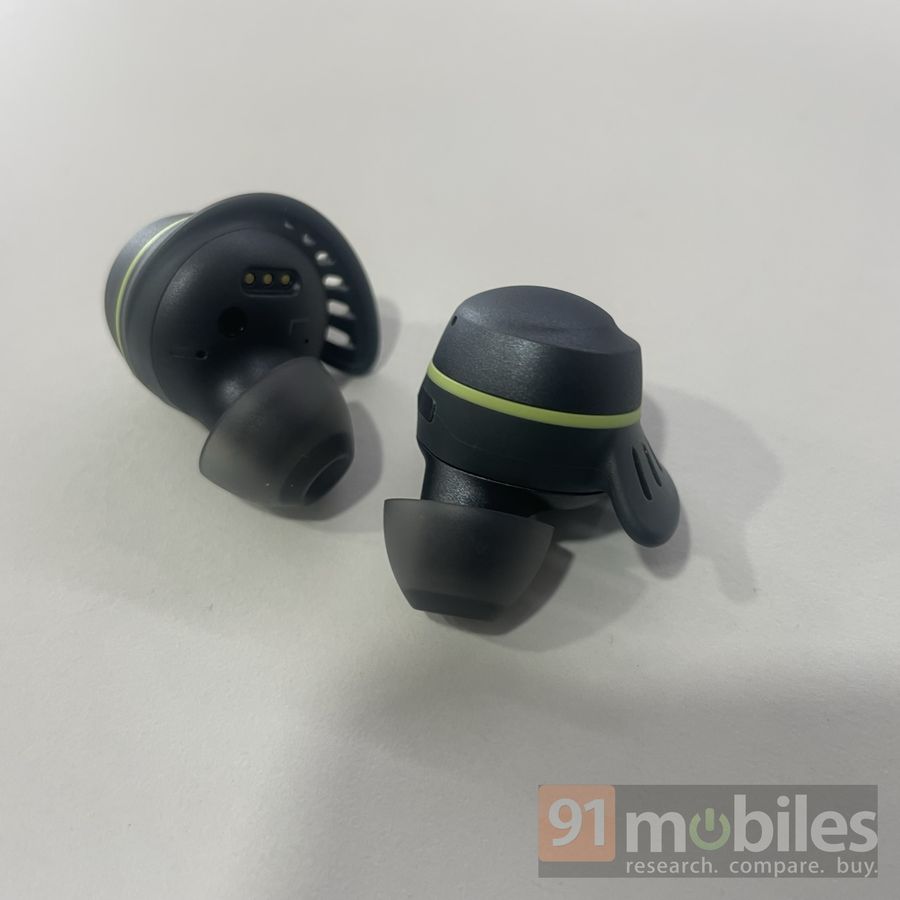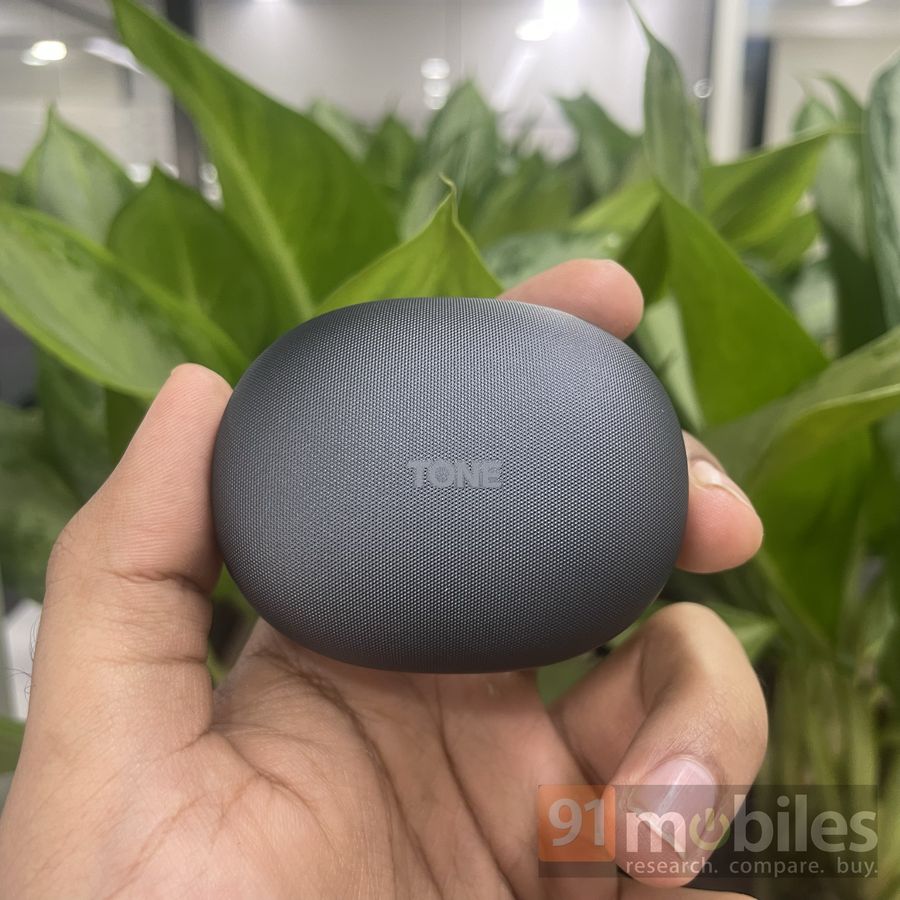If you haven’t been introduced to LG’s TWS earphones lineup yet, the LG Tone Free Fit TF7 is a great place to start. Despite its somewhat lengthy name, these earphones are packed with features that might intrigue you. The LG Tone Free Fit TF7 is priced in India at just under Rs 13,000. Keep reading to discover why they come close to being the perfect truly wireless earphones for sports and outdoor enthusiasts, as well as casual users, using an Android mobile phone or an iPhone. I’ve been using these earphones for well over a month now, and I must admit I didn’t miss my AirPods Pro all that much.
Table of Contents
Design
- The LG Tone Free Fit TF7 earbuds come in a pebble-shaped case, which may not exude a premium appearance but offers a satisfying in-hand feel. The case has a textured surface on its lid and other areas, effectively warding off scratches and resisting stains. There’s a USB Type-C port at the back for charging. On the front edge, you’ll find a charging indicator along with a UV nano light. That’s right, the device comes with a built-in Ultraviolet (UV) light which serves to effectively eliminate harmful bacteria from the earbuds, ensuring a cleaner and healthier listening experience for your ears.
- Moving on, the LG Tone Free Fit TF7 case has a lengthy slit at front, yet it remains challenging to open the lid with just one hand due to the clasp’s lack of strength. You will need assistance from your other hand to open the case and access the earbuds. Speaking of which, the buds boast a matte finish and an in-ear design, free of stems. Instead, they are equipped with rubber fins to ensure a secure fit, whether you are on the move or engaged in vigorous activities.You will have no trouble wearing these buds for an extended duration, owing to their lightweight design.

- If the default fins do not fit your ears comfortably, you have the option to replace them with other fins included in the package. Additionally, the buds come with ear tips of different sizes to fit most ears out there. That said, the LG Tone Free Fit TF7 may look bulkier than some of its competitors, but they are still manageable. The earbuds don’t noticeably protrude from the ears, and the case is compact enough to easily fit into any pocket.
Features
- The LG Tone Free Fit TF7 earbuds are IP67 rated, which is among the highest water and dust-resistance ratings you can get in the TWS segment right now. This means you can confidently wear these earbuds out in the rain or while working out without any worries. The earbuds have a touch-sensitive surface on the outer shell, which is customisable and works quite seamlessly. I didn’t have to use my phone to adjust the volume, change tracks, answer calls, and more. Moreover, it delivers nice feedback on every touch.

- Apart from this, these earbuds include wear detection, allowing them to automatically pause or play music when they are taken out of or placed back into the ears. The buds also feature AAC and SBC codecs. Regrettably, AptX support is absent, but the available codecs ensure minimal latency, to the extent that there is no perceptible delay between audio and video when streaming movies or playing games on your smartphone. However, it tends to reduce power consumption and affect the overall audio quality.
- In terms of connectivity, the Tone Free Fit TF7 is equipped with Bluetooth v5.3, enabling seamless pairing with your smartphone, laptop/PC, and other compatible devices. These buds offer multi-point connectivity, allowing you to pair with up to five devices simultaneously and effortlessly switch between them. However, it’s worth mentioning that there is no pairing button on the device, which means the buds will only become discoverable to new devices after they have been disconnected from others or through the companion app.

- Once connected, and if the ‘Multi-Point & Multi-Pairing‘ mode is enabled via the companion LG Tone Free app, the TF7 buds will automatically switch between audio sources, akin to Apple AirPods. However, unlike the AirPods, the multi-point connectivity is not restricted to a single ecosystem. It seamlessly functions across devices, be it Android, Mac, or iPhone. Having said that, there’s a noticeable lag of a few seconds when switching between sources, which can disrupt your experience, especially when watching a movie or TV show on your laptop and your paired smartphone receives notifications. I had to reconnect the earbuds to my laptop/ smartphone to restore audio functionality at times.
Companion app

- Talking about the companion app, the LG Tone Free is available for download on both Android and iOS devices via their respective app marketplace. While I mostly used the app (version number 1.2.72), on my Nothing Phone (2), I used it on my iPhone 12 for a brief period and it worked flawlessly there as well. There is no login required. Once the earbuds are connected, you can begin using the app to customise the earbuds to your preference. You have the flexibility to adjust EQ settings, either using preset options or crafting your own, control ambient sound and ANC, and toggle features like UVnano Always On, game mode, auto play/pause, Multi-point pairing, and more.
- The app also allows you to effortlessly download the latest firmware, fine-tune touch controls, locate your earbuds when they are out of sight and offer various other functionalities. In summary, this feature-rich app boasts a user-friendly interface, making it easy for you to explore and navigate through its wide range of options.
Sound quality and ANC
- For the audio, the LG Tone Free Fit TF7 earbuds have been neatly packaged with 6mm drivers, Meridian presets, Headphone Spatial Processing (HSP), and hybrid ANC. This combination delivers an expansive and immersive sound experience across all frequencies. I mostly used the earbuds with Bass Boost EQ settings, which left me absolutely mesmerised listening to songs like Zinda Banda and Chaleya from Jawan. Despite the relatively small driver size, the TF7 earbuds provided vocals with remarkable clarity and beats that had me grooving along. The Treble also feels nicely balanced.

- The earbuds also beautifully managed songs like Charlie Puth’s Left and Right and Queen’s Bohemia Rhapsody. Very satisfyingly, the TF7 transitioned the music between the earbuds as needed and handled the intricacies of these songs, especially the Bohemia Rhapsody, which packs a lot of instruments. There was an occasional dip in vibrancy, but that’s barely noticeable.
- Other than that, the LG Tone Free Fit TF7 also work well while watching a movie or TV show. However, for that, I suggest you enable the 3D Sound Stage EQ setting from the app, which delivers an immersive experience. It puts you in the centre of the scene, with sound emanating from all directions. While it all works out quite nicely, I wish the earphones also had the head tracking feature.

- Talking about the ANC, the LG Tone Free Fit TF7 did remarkably well cancelling out the background noise. The earphones feature hybrid ANC, which uses feedback and feedforward microphones to block unwarranted noise. It isn’t complete isolation, but the mechanism manages to bring the background noise down to a level where it is barely noticeable. I tested at the gym where I couldn’t even tell what was happening in the background or which music was blasting from those massive speakers. At a certain level, I found the ANC on the LG Tone Free Fit TF7 better than the AirPods Pro.
- Besides ANC, the Free Fit TF7 offers an Ambient mode with ‘Listening’ and ‘Conversation’ sub-modes. The former lets you hear ambient sound while still listening to music, while the Conversation mode allows you to hear voices more clearly. These modes work just fine and can be adjusted via the touch controls and the accompanying app.
Call quality and battery life
- The LG Tone Free Fit TF7 boasts terrific battery life. With the case, the earbuds have a claimed battery life of up to 30 hours on a single charge. In my real-world usage, I achieved similar results, with the earbuds lasting up to 5 hours when using ANC continuously. Without ANC, you can expect around 9-10 hours of battery life. The case can recharge the earbuds at least three times, thus, extending your total playtime and bringing it closer to the claimed battery life.

- The case comes with a Type-C port for charging and is touted to support fast charging, providing a full hour of playtime with just 10 minutes of charging. Be that as it may, the LG Tone Free Fit TF7 took around 60-90 minutes to fully charge a depleted battery to 100 percent.
- As for the call quality, you will face no issues taking the calls through the earbuds in a moderately loud environment. The buds make use of beamforming technology, which directs attention to your voice while effectively eliminating background noise.
Verdict
The LG Tone Free Fit TF7 offers an impressive blend of features and performance, making it a strong contender in the truly wireless earphone market. Priced at Rs 12,989 in India, it squares off closely against the OnePlus Buds Pro 2, which not only comes at a Rs 1,000 lower price point but also boasts larger drivers and advanced head tracking features, among others. It’s worth noting, however, that the LG earphones exhibit superior fit and durability compared to the OnePlus rival.
Additionally, the Tone Free Fit TF7 stands out with a sleek pebble-shaped case featuring UV sanitisation and IP67 water and dust resistance. The pair offers exceptional sound quality and hybrid ANC, which effectively eliminates background noise – better than some of the most expensive TWS earphones out there. While there are minor connectivity quirks, the multi-point functionality across different ecosystems is a plus. With great battery life and a feature-rich companion app, the LG Tone Free Fit TF7 is a compelling choice for both sports enthusiasts and casual users seeking premium wireless audio experiences.
Editor’s rating: 8.5 / 10
Pros
- Solid fit and durability
- Rich sound, good ANC
- User-friendly companion app
- Decent battery life
Cons
- Multi-point connectivity can be finicky
- Design can be bulky for some












